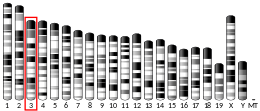P2RY1
P2Y purinoceptor 1 is a protein that in humans is encoded by the P2RY1 gene.[5]
Function
The product of this gene, P2Y1 belongs to the family of G-protein coupled receptors. This family has several receptor subtypes with different pharmacological selectivity, which overlaps in some cases, for various adenosine and uridine nucleotides. This receptor functions as a receptor for extracellular ATP and ADP. In platelets binding to ADP leads to mobilization of intracellular calcium ions via activation of phospholipase C, a change in platelet shape, and probably to platelet aggregation.[6]
See also
References
- GRCh38: Ensembl release 89: ENSG00000169860 - Ensembl, May 2017
- GRCm38: Ensembl release 89: ENSMUSG00000027765 - Ensembl, May 2017
- "Human PubMed Reference:". National Center for Biotechnology Information, U.S. National Library of Medicine.
- "Mouse PubMed Reference:". National Center for Biotechnology Information, U.S. National Library of Medicine.
- Ayyanathan K, Webbs TE, Sandhu AK, Athwal RS, Barnard EA, Kunapuli SP (January 1996). "Cloning and chromosomal localization of the human P2Y1 purinoceptor". Biochemical and Biophysical Research Communications. 218 (3): 783–8. doi:10.1006/bbrc.1996.0139. PMID 8579591.
- "Entrez Gene: P2RY1 purinergic receptor P2Y, G-protein coupled, 1".
Further reading
- Janssens R, Communi D, Pirotton S, Samson M, Parmentier M, Boeynaems JM (April 1996). "Cloning and tissue distribution of the human P2Y1 receptor". Biochemical and Biophysical Research Communications. 221 (3): 588–93. doi:10.1006/bbrc.1996.0640. PMID 8630005.
- Léon C, Vial C, Cazenave JP, Gachet C (June 1996). "Cloning and sequencing of a human cDNA encoding endothelial P2Y1 purinoceptor". Gene. 171 (2): 295–7. doi:10.1016/0378-1119(96)00027-3. PMID 8666290.
- Léon C, Hechler B, Vial C, Leray C, Cazenave JP, Gachet C (February 1997). "The P2Y1 receptor is an ADP receptor antagonized by ATP and expressed in platelets and megakaryoblastic cells". FEBS Letters. 403 (1): 26–30. doi:10.1016/S0014-5793(97)00022-7. PMID 9038354.
- Ayyanathan K, Naylor SL, Kunapuli SP (September 1996). "Structural characterization and fine chromosomal mapping of the human P2Y1 purinergic receptor gene (P2RY1)". Somatic Cell and Molecular Genetics. 22 (5): 419–24. doi:10.1007/BF02369897. PMID 9039850.
- Maier R, Glatz A, Mosbacher J, Bilbe G (August 1997). "Cloning of P2Y6 cDNAs and identification of a pseudogene: comparison of P2Y receptor subtype expression in bone and brain tissues". Biochemical and Biophysical Research Communications. 237 (2): 297–302. doi:10.1006/bbrc.1997.7135. PMID 9268704.
- Jin J, Daniel JL, Kunapuli SP (January 1998). "Molecular basis for ADP-induced platelet activation. II. The P2Y1 receptor mediates ADP-induced intracellular calcium mobilization and shape change in platelets". The Journal of Biological Chemistry. 273 (4): 2030–4. doi:10.1074/jbc.273.4.2030. PMID 9442040.
- Hall RA, Ostedgaard LS, Premont RT, Blitzer JT, Rahman N, Welsh MJ, Lefkowitz RJ (July 1998). "A C-terminal motif found in the beta2-adrenergic receptor, P2Y1 receptor and cystic fibrosis transmembrane conductance regulator determines binding to the Na+/H+ exchanger regulatory factor family of PDZ proteins". Proceedings of the National Academy of Sciences of the United States of America. 95 (15): 8496–501. doi:10.1073/pnas.95.15.8496. PMC 21104. PMID 9671706.
- Sabala P, Czajkowski R, Przybyłek K, Kalita K, Kaczmarek L, Barańska J (January 2001). "Two subtypes of G protein-coupled nucleotide receptors, P2Y(1) and P2Y(2) are involved in calcium signalling in glioma C6 cells". British Journal of Pharmacology. 132 (2): 393–402. doi:10.1038/sj.bjp.0703843. PMC 1572584. PMID 11159687.
- Yoshioka K, Saitoh O, Nakata H (June 2001). "Heteromeric association creates a P2Y-like adenosine receptor". Proceedings of the National Academy of Sciences of the United States of America. 98 (13): 7617–22. doi:10.1073/pnas.121587098. PMC 34717. PMID 11390975.
- James G, Butt AM (October 2001). "Changes in P2Y and P2X purinoceptors in reactive glia following axonal degeneration in the rat optic nerve". Neuroscience Letters. 312 (1): 33–6. doi:10.1016/S0304-3940(01)02189-9. PMID 11578839.
- Moore DJ, Chambers JK, Wahlin JP, Tan KB, Moore GB, Jenkins O, Emson PC, Murdock PR (October 2001). "Expression pattern of human P2Y receptor subtypes: a quantitative reverse transcription-polymerase chain reaction study". Biochimica et Biophysica Acta (BBA) - Gene Structure and Expression. 1521 (1–3): 107–19. doi:10.1016/S0167-4781(01)00291-3. PMID 11690642.
- Czajkowski R, Lei L, Sabała P, Barańska J (February 2002). "ADP-evoked phospholipase C stimulation and adenylyl cyclase inhibition in glioma C6 cells occur through two distinct nucleotide receptors, P2Y(1) and P2Y(12)". FEBS Letters. 513 (2–3): 179–83. doi:10.1016/S0014-5793(02)02255-X. PMID 11904146.
- Aktas B, Hönig-Liedl P, Walter U, Geiger J (August 2002). "Inhibition of platelet P2Y12 and alpha2A receptor signaling by cGMP-dependent protein kinase". Biochemical Pharmacology. 64 (3): 433–9. doi:10.1016/S0006-2952(02)01113-9. PMID 12147294.
- Nurden P, Poujol C, Winckler J, Combrié R, Pousseau N, Conley PB, Levy-Toledano S, Habib A, Nurden AT (February 2003). "Immunolocalization of P2Y1 and TPalpha receptors in platelets showed a major pool associated with the membranes of alpha -granules and the open canalicular system". Blood. 101 (4): 1400–8. doi:10.1182/blood-2002-02-0642. PMID 12393588.
- Burrell HE, Bowler WB, Gallagher JA, Sharpe GR (March 2003). "Human keratinocytes express multiple P2Y-receptors: evidence for functional P2Y1, P2Y2, and P2Y4 receptors". The Journal of Investigative Dermatology. 120 (3): 440–7. doi:10.1046/j.1523-1747.2003.12050.x. PMID 12603858.
- Jagroop IA, Burnstock G, Mikhailidis DP (February 2003). "Both the ADP receptors P2Y1 and P2Y12, play a role in controlling shape change in human platelets". Platelets. 14 (1): 15–20. doi:10.1080/0953710021000062914. PMID 12623443.
- Greig AV, Linge C, Terenghi G, McGrouther DA, Burnstock G (June 2003). "Purinergic receptors are part of a functional signaling system for proliferation and differentiation of human epidermal keratinocytes". The Journal of Investigative Dermatology. 120 (6): 1007–15. doi:10.1046/j.1523-1747.2003.12261.x. PMID 12787128.
- Wang L, Ostberg O, Wihlborg AK, Brogren H, Jern S, Erlinge D (February 2003). "Quantification of ADP and ATP receptor expression in human platelets". Journal of Thrombosis and Haemostasis. 1 (2): 330–6. doi:10.1046/j.1538-7836.2003.00070.x. PMID 12871508.
External links
- "P2Y Receptors: P2Y1". IUPHAR Database of Receptors and Ion Channels. International Union of Basic and Clinical Pharmacology.
This article incorporates text from the United States National Library of Medicine, which is in the public domain.
This article is issued from Wikipedia. The text is licensed under Creative Commons - Attribution - Sharealike. Additional terms may apply for the media files.




